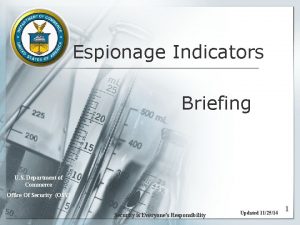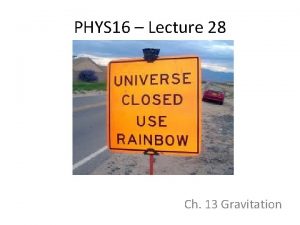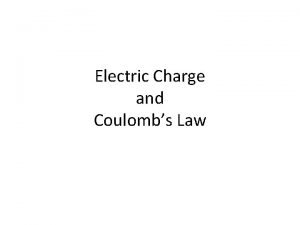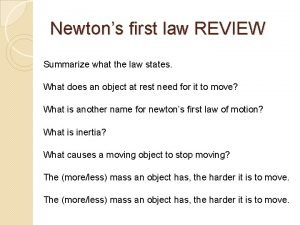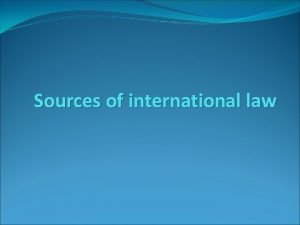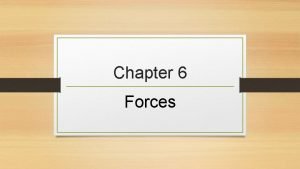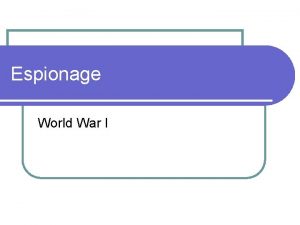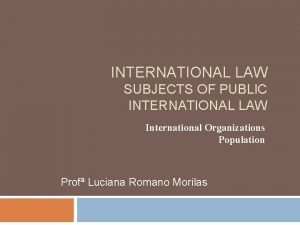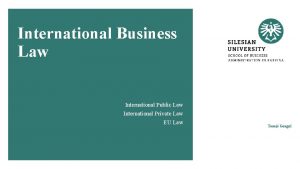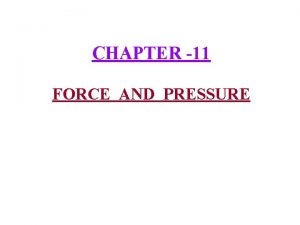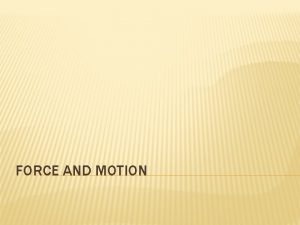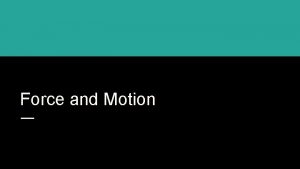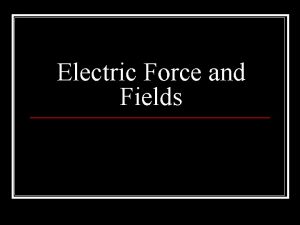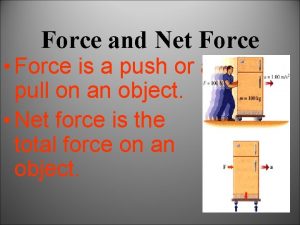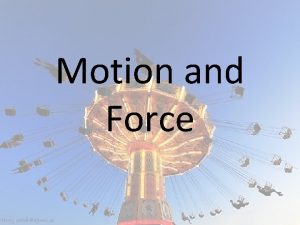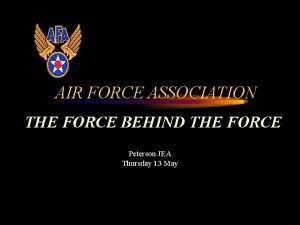INTERNATIONAL LAW USE OF FORCE AND ESPIONAGE THE




























































- Slides: 60

INTERNATIONAL LAW USE OF FORCE AND ESPIONAGE: THE RAINBOW WARRIOR AFFAIR SUMMARY

Rainbow Warrior

Rainbow Warrior

Rainbow Warrior • a former UK Ministry of Agriculture, Fisheries and Food trawler later purchased by Greenpeace • active in supporting a number of protest activities against seal hunting, whaling and nuclear weapons testing in the late 1970 s and early 1980 s

Rainbow Warrior • campaigning against nuclear testing in the Pacific • evacuated some 300 Marshall Islanders from Rongelap Atoll, polluted by radioactivity from past American nuclear tests in the Pacific • travelled to New Zealand to lead a flotilla of yachts protesting against French nuclear testing in the French Polynesia

French Polynesia

The Mururoa Atomic Test Site in French Polynesia

French Polynesia 1946 Polynesians granted French citizenship the islands' status changed to an overseas territory; the islands' name changed in 1957 to Polynésie Française (French Polynesia). In 1962, France's early nuclear testing ground of Algeria became independent and the Maruroa atoll in the Tuamotu Archipelago selected as the new testing site; Tests - conducted underground after 1974. • 1977 French Polynesia granted partial internal autonomy; 1984 the autonomy was extended. • •

French Polynesia • In Sept. 1995, France stirred up widespread protests by resuming nuclear testing after a three-year moratorium • The last test: 27 Jan. 1996. • On 29 Jan. 1996, France announced that it would accede to the Comprehensive Test Ban Treaty, and no longer test nuclear weapons

Rainbow Warrior • Greenpeace intended to monitor the impact of nuclear tests and place protesters on the island to monitor the blasts • The French Government infiltrated the organisation and discovered these plans

Rainbow Warrior • Moored in Auckland Harbour, New Zealand • sabotaged and sunk just before midnight on July 10, 1985 by two explosive devices attached to the hull by operatives of the French intelligence service • Photographer Fernando Pereira returned to the ship after the first explosion to try to retrieve his equipment; killed when the ship was sunk by the second larger explosion

Rainbow Warrior sunk

Rainbow Warrior • Towed north with a patched hull on 2 Dec. 1987. • Ten days later, it was given a traditional Maori burial. • Now home to a complex ecosystem, it has become a popular dive destination • In a few years, it became an integral part of the environment it helped protect.

Memorial to the Rainbow Warrior at Matauri Bay, Northland

Location of Rainbow Warrior

Facts of the case • 12 July 1985, 2 DGSE agents using false names were arrested in New Zealand Charged with passport and related offences • 23 July, further charged with conspiracy to commit arson, wilfully damaging the Rainbow Warrior by explosives, and with the murder of Fernando Pereira • Pleaded not guilty; remanded in custody • Identified as Alain Mafart and Dominique Prieur

Alain Mafart and Dominique Prieur

Facts of the case • 4 Nov. 1985 charges altered to manslaughter and wilful damage • 22 Nov. 1985 agents pleaded guilty • Sentenced to 10 years imprisonment for manslaughter and • 7 years for wilful damage, to run concurrently • 28 Nov. French Defence Minister urged negotiations for the agents’ return to France

Facts of the case • 26 July: police issued warrants to arrest agents who had left New Zealand prior to explosions • 13 August: New Zealand demanded extradition of all involved • French government’s reply: it could not extradite French nationals • Other agents – never apprehended • In addition to those successfully prosecuted, a two-men team had carried out the actual bombing but their identities have never been officially confirmed.

Facts of the case • 26 Aug. 1985 results of investigation of the French Government into the possibility of official involvement were published • No evidence their mission involved anything other than surveillance 6 Sept. France notified New Zealand that the agents should enjoy guarantees of international law 22 Sept. France acknowledged that the agents had obeyed orders and should be exempted from blame

Rainbow Warrior • On 22 Sept. 1985, the French Prime Minister Laurent Fabius read a statement saying: "Agents of the French secret service sank this boat. They were acting on orders. "

Facts of the case • 6 Sept. New Zealand notified France it would take legal steps to secure compensation from France • 26 Sept. New Zealand PM prohibited extradition and political interference in the legal proceedings • 16 Dec. New Zealand would consider repatriating agents if they continue to serve their prison sentences • 19 May 1986 New Zealand suspended negotiations in protest at economic sanctions by France • (France impeded New Zealand imports)

Facts of the case • On 12 Sept. 1985 European Parliament condemned secret service activity; demanded explanation from France • 19 June 1986 France and New Zealand agreed to refer all matters to arbitration by the UN Secretary General • 6 July 1986 the ruling was completed; signed on 9 July: • Transfer Mafart and Prieur to French custody; France must not impede New Zealand exports to EC

Facts of the case • 12 Nov. 1985 France reached settlement with the family of • Fernardo Pereira: formal apology, compensation, • reimbursement to insurers • 19 Dec. France and Greenpeace agreed to negotiate damages

Facts of the case • Greenpeace and the French Republic agreed to submit Greenpeace's claims against France to international arbitration. • The arbitral tribunal, seated in Geneva -composed of 3 members (Prof. Claude Reymond, Sir Owen Woodhouse and Prof. Francois Terre) rendered an award in 1987 in favor of Greenpeace, ordering France to pay it some $ 8. 1 million

Facts of the case • David Mc. Taggart, Greenpeace's chairman, described the award as "a great victory for those who support the right of peaceful protest and abhor the use of violence. "

Rainbow Warrior • “Her voyage into history was cut short by two limpet mines in 1985, when frightened politicians in Paris ordered French agents to sink the ship in New Zealand, believing this would stop our protests against nuclear weapons tests. One crew member was murdered in the attack – photographer Fernando Pereira.

Rainbow Warrior • “It was a massive miscalculation, catalyzing opposition throughout the Pacific, strengthening Greenpeace, and hardening our resolve to rebuild and return. A supporter in Auckland coined the phrase that became a motto of opposition: “You Can’t Sink a Rainbow. ”

Contravention of International Law • Officially inspired military operation with strictly limited intentions • Low-level uses of force • International delinquency • Infringement of New Zealand sovereignty

Contravention of International Law • Agents – involved in spying • 1907 Hague Convention deals with spying in wartime; • no peacetime equivalent • Espionage – illegal but tolerated in many countries • ‘reciprocally tolerated espionage’

Contravention of International Law • Concept of state criminality – not supported by law • States – liability for reparations • A state which sends agents to commit acta jure imperii abroad is liable rather than the agents who should enjoy immunity from local courts • Individuals – increasingly recognised as subjects of international law • Liability of individuals for war crimes and crimes against humanity • New Zealand – superior orders – no defence

Contravention of International Law • 1907 Hague Conventions: ‘soldiers privileges’, conditional on obedience to law customs of war • At lower thresholds of conflict governments apply their own criminal law • The agents – no POW status according to 1977 Geneva Protocol • International law – inadequate to deal with perpetrators of sporadic violence across State boundaries • Impossible to establish immunity from local jurisdiction for perpetrators making illegal entries with the official purpose of committing unlawful acts

Contravention of International Law • International doctrine of non-intervention • The Rainbow Warrior: challenges the principle that either a State or its agents – but not both- are liable for acts contrary to law outside the Geneva Conventions

Nurenberg Charter Art. 6 • The following acts, or any of them, are crimes coming within the jurisdiction of the Tribunal for which there shall be individual responsibility: • (a) CRIMES AGAINST PEACE: (…) • (b) WAR CRIMES: (…) • (c) CRIMES AGAINST HUMANITY (…)

Nurenberg Charter • Article 8 • The fact that the Defendant acted pursuant to order of his Government or of a superior shall not free him from responsibility, but may be considered in mitigation of punishment if the Tribunal determines that justice so requires

1977 Protocol Additional to the Geneva Conventions of 12 August 1949, and relating to the Protection of Victims of International Armed Conflicts (Protocol I) • Art 44. Combatants and prisoners of war 1. Any combatant, as defined in Article 43, who falls into the power of an adverse Party shall be a prisoner of war. 2. While all combatants are obliged to comply with the rules of international law applicable in armed conflict, violations of these rules shall not deprive a combatant of his right to be a combatant or, if he falls into the power of an adverse Party, of his right to be a prisoner of war, except as provided in paragraphs 3 and 4. (…)

Espionage: Powers Case, 1960 • The U-2 incident occurred during the Cold War on May 1, 1960, during the presidency of Dwight Eisenhower and the leadership of Soviet Premier Nikita Khrushchev, when a US U-2 spy plane was shot down over the airspace of the Soviet Union

Powers Case, 1960 • The US government at first denied the plane's purpose and mission, but then was forced to admit its role as a covert surveillance aircraft when the Soviet government produced its intact remains and surviving pilot, Francis Gary Powers, as well as photos of military bases in Russia taken by Powers.

Powers Case, 1960 • Coming roughly two weeks before the scheduled opening of an East– West summit in Paris, the incident was a great embarrassment to the US and prompted a marked deterioration in its relations with the Soviet Union.

Powers Case, 1960 • Powers pleaded guilty and was convicted of espionage on August 19 and sentenced to three years imprisonment and seven years of hard labor. • He served one year and nine months of the sentence before being exchanged for Rudolf Abel on February 10, 1962

Caroline case • a series of events beginning in 1837 that strained relations between the US and Britan • A group of Canadian rebels, seeking a Canadian republic, were forced to flee to the US after leading the failed Upper Canada Rebellion in Upper Canada (now Ontario)

Caroline case • They took refuge on the Canadian side of the Niagara River, which separates Ontario and New York and declared themselves the Republic of Canada • American sympathizers supplied them with money, provisions, and arms via the steamboat SS Caroline.

Caroline case • On December 29, two Canadian loyalists, acting on information and guidance from Alexander Mc. Leod, crossed the international boundary and seized the Caroline, towed her into the current, set her afire, and cast her adrift over Niagara Falls, after killing one black American

Caroline case • Three years later, Mc. Leod was arrested by the US and charged with murder, but his incarceration infuriated Canada and Great Britain, which demanded his repatriation; suggesting that any action taken against the Caroline had been taken under orders, and the responsibility lay with Great Britain, not Mc. Leod himself.

Caroline case • The incident - used to establish the principle of "anticipatory selfdefense" in international politics, which holds that it may be justified only in cases in which the "necessity of that self-defence is instant, overwhelming, and leaving no choice of means, and no moment for deliberation".

The Schooner Exchange v. Mc. Faddon (1812) • The Schooner Exchange, owned by John M'Faddon and William Greetham, sailed from Baltimore, Maryland, on October 27, 1809, for St. Sebastians, Spain. • On December 30, 1810, the Exchange was seized by order of Napoleon Bonaparte. • The Exchange was then armed and commissioned as a public vessel of the French government under the name of Balaou

The Schooner Exchange v. M'Faddon • M'Faddon and Greetham claimed that they owned the Balaou, which had docked at a U. S. port due to bad weather. • They believed that the Balaou was illegally seized by the government of France. At the time, France was involved with the War of 1812

The Schooner Exchange v. M'Faddon • The district court in the case found in favor of the French Government, finding that the M'Faddon and Greetham had no right to the Balaou as it belonged to the French government who were allies of the United States

The Schooner Exchange v. M'Faddon • The circuit court, on appeal, reversed the decision of the district court, granting property rights to the M'Faddon & Greetham. • The Supreme Court reversed the circuit court's decision, and affirmed the district court's dismissal of the action.

The Schooner Exchange v. M'Faddon • The case centered on the jurisdiction of federal courts over a claim against a friendly foreign military vessel visiting an American port. • The court interpreted customary international law to determine that there was no jurisdiction

The Schooner Exchange v. M'Faddon • But in all respects different is the situation of a public armed ship. She constitutes a part of the military force of her nation; acts under the immediate and direct command of the sovereign; is employed by him in national objects. He has many and powerful motives for preventing those objects from being defeated by the interference of a foreign state.

The Schooner Exchange v. M'Faddon • Such interference cannot take place without affecting his power and his dignity. The implied license therefore under which such vessel enters a friendly port, may reasonably be construed, and it seems to the Court, ought to be construed, as containing an exemption from the jurisdiction of the sovereign, within whose territory she claims the rites of hospitality (11 U. S. 144).

Significance of the case • The decision is regarded as the "first definitive statement of the doctrine of foreign state immunity • State immunity: protection which a state is given from being sued in the courts of other states

The 1998 Rome Statute of the International Criminal Court • Article 33, titled "Superior orders and prescription of law: • 1. The fact that a crime within the jurisdiction of the Court has been committed by a person pursuant to an order of a Government or of a superior, whether military or civilian, shall not relieve that person of criminal responsibility unless:

The 1998 Rome Statute of the International Criminal Court • (a) The person was under a legal obligation to obey orders of the Government or the superior in question; • (b) The person did not know that the order was unlawful; and • (c) The order was not manifestly unlawful. • 2. For the purposes of this article, orders to commit genocide or crimes against humanity are manifestly unlawful.

Law and the Rainbow Warrior • The Rainbow Warrior affair bolsters the notion that there is an international doctrine of non-intervention. France was obliged to recognise this, and also to make restitution for contravening the doctrine outlawing armed atttack.

Law and the Rainbow Warrior • Further, the case may have a positive long-term benefit in drawing attention to those areas of deficiency, remarked on by Falk, Lauzchterpacht, Crawford and others, in both the substantive rule of international law and its procedures, especially concerning immunity, low-level force, and peacetime espionage.

Law and the Rainbow Warrior • Certainly in government torts the international trend in State practice is to restrict State immunity and assert local jurisdiction, to the extent that it has been said to contribute to the ‘demystification of the State as a supreme being’.

Law and the Rainbow Warrior • Jurists will note that the outcome of the inter-government dispute was based on an individual’s concept of fairness, producing a ruling rather than a legal judgment.

Law and the Rainbow Warrior • Yet in so far as the settlement can be considered as an example of State practice, it significantly challenges the principle that either a State or its agents – but not both – are liable for acts contrary to law outside the Geneva Convention.
 Espionage indicators
Espionage indicators Potential espionage indicators
Potential espionage indicators The espionage act of 1917
The espionage act of 1917 Pengertian cyber ethics
Pengertian cyber ethics Newton's first law and second law and third law
Newton's first law and second law and third law Newton's first law of motion
Newton's first law of motion Boyles law
Boyles law Constant in avogadro's law
Constant in avogadro's law Centripetal force and gravitational force
Centripetal force and gravitational force Normal force and gravitational force
Normal force and gravitational force Internal force
Internal force Electric charge
Electric charge Newton's law
Newton's law Laws of acceleration
Laws of acceleration Whatthelaw
Whatthelaw Difference between monism and dualism in international law
Difference between monism and dualism in international law Hát kết hợp bộ gõ cơ thể
Hát kết hợp bộ gõ cơ thể Lp html
Lp html Bổ thể
Bổ thể Tỉ lệ cơ thể trẻ em
Tỉ lệ cơ thể trẻ em Gấu đi như thế nào
Gấu đi như thế nào Glasgow thang điểm
Glasgow thang điểm Chúa yêu trần thế alleluia
Chúa yêu trần thế alleluia Môn thể thao bắt đầu bằng chữ f
Môn thể thao bắt đầu bằng chữ f Thế nào là hệ số cao nhất
Thế nào là hệ số cao nhất Các châu lục và đại dương trên thế giới
Các châu lục và đại dương trên thế giới Công thức tính độ biến thiên đông lượng
Công thức tính độ biến thiên đông lượng Trời xanh đây là của chúng ta thể thơ
Trời xanh đây là của chúng ta thể thơ Cách giải mật thư tọa độ
Cách giải mật thư tọa độ 101012 bằng
101012 bằng độ dài liên kết
độ dài liên kết Các châu lục và đại dương trên thế giới
Các châu lục và đại dương trên thế giới Thể thơ truyền thống
Thể thơ truyền thống Quá trình desamine hóa có thể tạo ra
Quá trình desamine hóa có thể tạo ra Một số thể thơ truyền thống
Một số thể thơ truyền thống Bàn tay mà dây bẩn
Bàn tay mà dây bẩn Vẽ hình chiếu vuông góc của vật thể sau
Vẽ hình chiếu vuông góc của vật thể sau Nguyên nhân của sự mỏi cơ sinh 8
Nguyên nhân của sự mỏi cơ sinh 8 đặc điểm cơ thể của người tối cổ
đặc điểm cơ thể của người tối cổ Thứ tự các dấu thăng giáng ở hóa biểu
Thứ tự các dấu thăng giáng ở hóa biểu Vẽ hình chiếu đứng bằng cạnh của vật thể
Vẽ hình chiếu đứng bằng cạnh của vật thể Phối cảnh
Phối cảnh Thẻ vin
Thẻ vin đại từ thay thế
đại từ thay thế điện thế nghỉ
điện thế nghỉ Tư thế ngồi viết
Tư thế ngồi viết Diễn thế sinh thái là
Diễn thế sinh thái là Các loại đột biến cấu trúc nhiễm sắc thể
Các loại đột biến cấu trúc nhiễm sắc thể Thế nào là số nguyên tố
Thế nào là số nguyên tố Tư thế ngồi viết
Tư thế ngồi viết Lời thề hippocrates
Lời thề hippocrates Thiếu nhi thế giới liên hoan
Thiếu nhi thế giới liên hoan ưu thế lai là gì
ưu thế lai là gì Hổ sinh sản vào mùa nào
Hổ sinh sản vào mùa nào Khi nào hổ mẹ dạy hổ con săn mồi
Khi nào hổ mẹ dạy hổ con săn mồi Hệ hô hấp
Hệ hô hấp Từ ngữ thể hiện lòng nhân hậu
Từ ngữ thể hiện lòng nhân hậu Thế nào là mạng điện lắp đặt kiểu nổi
Thế nào là mạng điện lắp đặt kiểu nổi Contact vs non contact forces
Contact vs non contact forces Vt=2pir/t
Vt=2pir/t Contact vs long range force
Contact vs long range force

